Over the next few weeks, I pulled all of the microfilm records from 1876 through to 1920 and photocopied all the pages that listed businesses under the categories "Distillers and Rectifiers" and the "Wines & Liquors, Wholesale". At home, I entered the listings into a database, noting the years that the companies appeared in the directories, their name, their address, and how they were described - wholesaler, importer, or distiller and rectifier. If you do this yourself, you'll be surprised by how frequently names of companies change, how frequently they move, and by all the spelling mistakes you'll encounter!
| By the time I was done, I had a database that covered the years between 1876 and 1918 and contained around 1,350 individual businesses. This was pretty staggering considering that I'd only included wholesalers, not the retailers. Had I done so, the database would contain closer to 10,000 entries! And I now knew that Humphrey & Martin was actually operating& as L. Humphrey & Bro. in the early years, only becoming Humphrey & Martin around 1884. I already knew from the billhead that the Humphrey of shot-glass fame was Samuel, so maybe L. Humphrey was his Dad or perhaps Samuel was the brother in "L. Humphrey & Bro." By 1918, Martin had disappeared from the company name, leaving Samuel Humphrey in charge, but in all those years they never moved from their original premises at 401-403 North Third Street. |
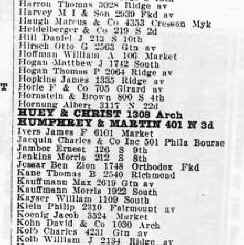 |
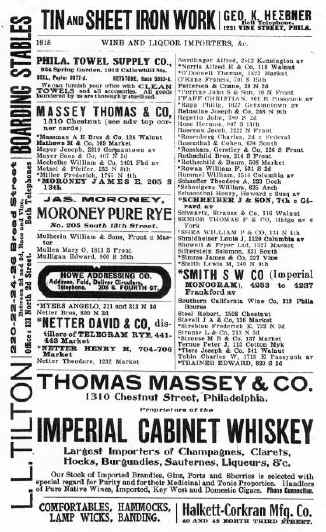 |
The business directories proved to be very useful in many ways. By listing companies by category, they allowed me to zero in on the old liquor industry straight away. Another big bonus is that the directories are full of advertising - several full pages at the beginning, full filler pages interspersed at various points throughout the directory, and every margin of every page was stuffed full of mini ads. By keeping your eyes open as you cruise through the microfilms, you can learn much from these ads because they contain brand names. After I was done, I was able to add about 30 or so to Bob Snyder's book and they've since been incorporated in one of his periodic updates. |
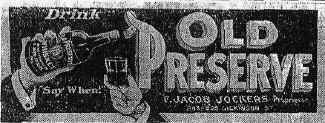 |
 |
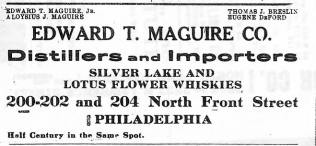 |
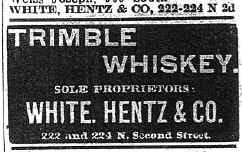 |
|
Shown here are a sampling of the many ads identifying brand names that appear in the business directories. |
The bad thing about the business directories is that the old companies had to pay to get listed. In practice, this meant that only the larger ones appeared with any regularity; many of the other smaller wholesalers appeared once, if at all, and then were gone. The other problem is that directories for some years are missing, incomplete, or so badly degraded that they are impossible to read. Thus, we can only obtain a sketchy outline of the city's history. To learn more, we have to go into the city directories.
The city directory is also kept on microfilm but it's organized alphabetically and hence requires a different approach. There'll be no photocopying for later scrutiny, instead we have to painstakingly scroll through the listings finding one name at a time. This is tough and time consuming work and there is no way that a database containing 1,300+ names can be fleshed out in its entirety.
Instead, I selected a group of around 30 businesses who I knew had produced shot glasses or were likely to have produced shot glasses given the amount of other advertising they generated. Humphrey & Martin were, of course, among them. These were the ones that I was going to chase through history and learn as much about as I could.
The city directories surprised me in the thoroughness of their listings. ; They're not like a modern telephone directory where there's a name and number and maybe an address. They contain names and occupations. They give the full name of the individuals, their home address, and their work address. If they're in partnership with others in the company they worked for, then we find out who the partners are (names in full) and also their precise role in the company. Widows are listed with a note of their deceased husband's name. All that's missing really is a Social Security number, most likely because they did not exist back then (they were first issued in 1936). It's an identity thief's dream come true!
It's probably best to start with the early years of the industry and then work toward Prohibition, jumping say 5 or 10 years at a time. It allows you to see the evolution of the industry over time and makes it easier to track individuals as they move from one company to another, or to see where a favorite individual was working before they set up their liquor store. I would advise writing down everything in the listing, even though it may not seem relevant at the time. It's particularly important to note the home addresses, because that may be the only way to tell if a bartender or clerk has become a wholesaler, for example. A major career change can cause you to lose an individual if the name was a common one. It also helps you see when a son set out on his own to start his own liquor business in competition with his dad, for example.
So what more have I learned about Humphrey & Martin? So far not a great deal. It takes an hour or two to research a single year using the city directories and my time and stamina has been limited to only a couple of sessions. I'll update as I find out more.....